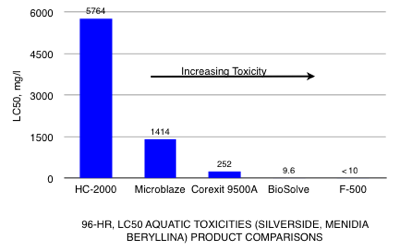24 Hr Emergency Response
800-377-3648

10,000 Environmental Remediations Since 1975
Remtech © 2025
| CAREERS |
| Contact Us
Copyright © 2016 Remtech Engineers

Range Finding Bioassay Tests
INTRODUCTION
Toxicity screens were conducted on HC-2000 bioremediation product and Micro-blaze (agent in water only) between March 12 and March 15, 2010. Fathead minnows (Pimephales promelas) were exposed to five concentrations of Micro-blaze and six concentrations of HC-2000 in freshwater. Tests were conducted at Remtech's research lab in Marietta, Georgia. Both bioremediation agents suggest a dosage rate of 3 to 6 percent. Acute, static, range-finding aquatic bioassays were conducted over a 96-hour period. Dissolved oxygen, pH and temperature were monitored throughout the assay period. Two liter test solutions were made up in one-gallon glass test chambers.
Note that HC-2000 applied at 3% is 50% less toxic to fathead minnows than at 6%. Test results are summarized below:
HC-2000, 6% solution
Fathead Minnows 96-hr - LC50 = 5,764 ppm (11,528 ppm at 3%)
Micro-blaze, 6% solution
Fathead Minnows 96-hr - LC50 = 1,414 ppm
RANGE FINDING TOXICITY METHOD
Fathead minnows were subjected to a 96-hour, acute, static, range-finding aquatic toxicity test (using an abbreviated ASTM E729-96 method without duplicates and smaller sample size). The LC50 data was calculated using the Trimmed Spearman-Karger Method and the results are given in parts per million (ppm) (2). Test fish were obtained from Davis Fish Farm located in Leesburg, Alabama.
Toxicity screening on Remtech's HC-2000 (Biostimulation Agent) and Verde Environmental's Micro-blaze (Enhanced Bioremediation Agent) was conducted at Remtech's research lab in Marietta, Georgia to determine the expected median lethal concentration (LC50) using the Fathead Minnow (Pimephales promelas) as the test organism. Five concentrations of Micro-blaze and six test concentrations of HC-2000 were tested with a total of 7 to 12 minnows in each reactor. During the 96-hour experiment, dissolved oxygen concentration, pH and temperature were monitored to assure optimal water quality conditions. LC50 (median lethal concentration) were calculated using the Trimmed Spearman-Karger Method and the results are given in parts per million (ppm).
Micro-blaze concentration ranges tested were: 600, 1000, 2000, 3000, and 6000 ppm.
HC-2000 concentration ranges tested were: 600, 1000, 3000, 6000, 8000, and 10000 ppm.
Flathead minnows were as uniform as possible in age and size. Dissolved oxygen levels were maintained between 60 and 100% of saturation and the fish did not incur a temperature fluctuation of more than 1 deg C in any 12-hour period. 7 to 12 fish were placed in each 2 liter chamber and were exposed to varying concentrations of each agent.
RANGE FINDING TOXICITY DISCUSSION
Remtech bioassay test results for Micro-blaze toxicity compared favorably to those reported on their website and FAA document respectively:
Coastal Bioanalysts for Verde Environmental, 1998
Micro-blaze 6% solution
Mysidopsis bahai 48-hr - LC50 = 1,230 ppm
estuarine mysid shrimp
Menidia beryllina 96-hr - LC50 = 1,390 ppm
inland silverside (coastal and freshwater habits)
Federal Aviation Administration, Aquatic Toxicity Screening of Fire Fighting Agents, 2003
(Applied Research Associates, Inc.), Tyndall AFB, FL.
Micro-blaze Out, 6% solution
Fathead Minnows 48-hr - LC50 = 949 mg/l
RANGE FINDING TOXICITY RESULTS
Micro-blaze is approximately 4.1 times more acutely toxic to fathead minnows in freshwater than HC-2000. When compared to EPA NCP 96-hr LC50 aquatic toxicity tests on the inland silverside, Menidia beryllina, (1), HC-2000 appears to be over an order of magnitude less toxic than the dispersant (Corexit 9500A) used on the recent Gulf oil spill (Deepwater Horizon oil exploration platform on April 20, 2010):
TRIMMED SPEARMAN-KARBER METHOD. VERSION 1.5
ENTER DATE OF TEST:
3/12/10
ENTER TEST NUMBER
1
WHAT IS TO BE ESTIMATED?
ENTER L FOR LC50 AND E FOR EC50
L
ENTER TEST SPECIES NAME:
fathead minnow
ENTER TOXICANT NAME:
Micro-blaze 6% Solution
ENTER UNITS FOR EXPOSURE CONCENTRATION OF TOXICANT:
mg/l
ENTER THE NUMBER OF INDIVIDUALS IN THE CONTROL:
10
ENTER THE NUMBER OF MORTALITIES IN THE CONTROL:
0
ENTER THE NUMBER OF CONCENTRATIONS
<NOT INCLUDING THE CONTROL; MAX - 10>:
5
ENTER THE 5 EXPOSURE CONCENTRATIONS <IN INCREASING ORDER>:
600, 1000, 2000, 3000, 6000
ARE THE NUMBER OF INDIVIDUALS AT EACH EXPOSURE CONCENTRATION EQUAL <Y/N>
n
ENTER THE NUMBER OF INDIVIDUALS AT EACH EXPOSURE CONCENTRATION:
10, 7, 10, 6, 8
ENTER UNITS FOR DURATION OF EXPERIMENT
<ENTER H FOR HOURS, D FOR DAYS, ETC>:
h
ENTER DURATION OF TEST:
96
ENTER THE NUMBER OF MORTALITIES AT EACH EXPOSURE CONCENTRATION:
0, 0, 7, 6, 8
WOULD YOU LIKE THE AUTOMATIC TRIM CALCULATION <Y/N>?
y
DATE: 3/12/10
TEST NUMBER: 1
DURATION: 96 HR
TOXICANT: Micro-blaze 6% Solution
SPECIES: fathead minnow
SPEARMAN-KARBER TRIM:
SPEARMAN-KARBER ESTIMATES: LC50 1667.57
95% LOWER CONFIDENCE 1422.14
95% UPPER CONFIDENCE 1955.35
TRIMMED SPEARMAN-KARBER METHOD. VERSION 1.5
ENTER DATE OF TEST:
3/12/10
ENTER TEST NUMBER
2
WHAT IS TO BE ESTIMATED?
ENTER L FOR LC50 AND E FOR EC50L
ENTER TEST SPECIES NAME:
fathead minnow
ENTER TOXICANT NAME:
HC-2000 6% Solution
ENTER UNITS FOR EXPOSURE CONCENTRATION OF TOXICANT:
mg/l
ENTER THE NUMBER OF INDIVIDUALS IN THE CONTROL:
10
ENTER THE NUMBER OF MORTALITIES IN THE CONTROL:
0
ENTER THE NUMBER OF CONCENTRATIONS
<NOT INCLUDING THE CONTROL; MAX - 10>:
6
ENTER THE 6 EXPOSURE CONCENTRATIONS <IN INCREASING ORDER>:
600, 1000, 3000, 6000, 8000, 10000
ARE THE NUMBER OF INDIVIDUALS AT EACH EXPOSURE CONCENTRATION EQUAL <Y/N>
n
ENTER THE NUMBER OF INDIVIDUALS AT EACH EXPOSURE CONCENTRATION:
8, 7, 7, 8, 12, 12
ENTER UNITS FOR DURATION OF EXPERIMENT
<ENTER H FOR HOURS, D FOR DAYS, ETC>:
h
ENTER DURATION OF TEST:
96
ENTER THE NUMBER OF MORTALITIES AT EACH EXPOSURE CONCENTRATION:
0, 0, 0, 3, 12, 12
WOULD YOU LIKE THE AUTOMATIC TRIM CALCULATION <Y/N>?
y
DATE: 3/12/10
TEST NUMBER: 2
DURATION: 96 HR
TOXICANT: HC-2000 6% Solution
SPECIES: fathead minnow
SPEARMAN-KARBER TRIM:
SPEARMAN-KARBER ESTIMATES: LC50 5764.37
95% LOWER CONFIDENCE 4873.50
95% UPPER CONFIDENCE 6818.07


REFERENCES
- 1. Comparative Toxicity of Eight Oil Dispersant Products on Two Gulf of Mexico Aquatic Test Species, EPA, U.S. Environmental Protection Agency Office of Research and Development, June 30, 2010.
- 2. Best Achievable Technology, Applied Response Technologies (ART), California Department of Fish and Wildlife Office of Spill Prevention and Response (CDFW-OSPR), Dec., 2016
- 3. Trimmed Spearman-Karber Method, Version 1.5 for HC-2000 presented below:
Range Finding Aquatic Toxicities of Enhanced Bioremediation Degrader Product (HC-2000)
** CDFW-OSPR - Prohibited in California
(LC50’s < 10 mg/l)
Dec, 2016 (3)